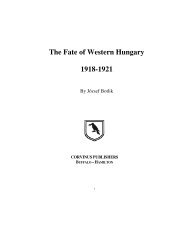Hungary and the Hungarians - Corvinus Library - Hungarian History
Hungary and the Hungarians - Corvinus Library - Hungarian History
Hungary and the Hungarians - Corvinus Library - Hungarian History
Create successful ePaper yourself
Turn your PDF publications into a flip-book with our unique Google optimized e-Paper software.
László Jambor<br />
HUNGARIAN MUSIC<br />
“I was twenty-seven years old <strong>and</strong> lived in Budapest, completely isolated from all <strong>the</strong><br />
new musical ideas, trends <strong>and</strong> techniques that had begun to appear in <strong>the</strong> West after <strong>the</strong><br />
war. The decisive turning point in my development as a composer occurred in 1956” -<br />
wrote György Ligeti, one of <strong>the</strong> most prominent modern composers of <strong>the</strong> end of <strong>the</strong> 20 th<br />
century. Similar sentiments voiced also thous<strong>and</strong>s <strong>and</strong> thous<strong>and</strong>s of <strong><strong>Hungarian</strong>s</strong> at <strong>the</strong><br />
time, each according to his or her vocation, among <strong>the</strong>m writers <strong>and</strong> publicists like <strong>the</strong><br />
now Canadian George Jonas, Stephen Vizinczey, violinist Marta Hidy, pianist Bálint<br />
Vázsonyi, <strong>the</strong> guitarist Szabó Gábor <strong>and</strong> uncountable o<strong>the</strong>rs for whom <strong>the</strong> Uprising<br />
of 1956 came as cause or opportunity for escaping <strong>the</strong> confines of a totalitarian system.<br />
from <strong>the</strong>n on, <strong>the</strong> stage of western cultural life became populated with an ever increasing<br />
number of <strong><strong>Hungarian</strong>s</strong>, particularly musicians. It is perhaps puzzling how a small country<br />
could give a so disproportionally high contribution to <strong>the</strong> international musical life.<br />
It is true that <strong>the</strong> dramatic exodus that followed <strong>the</strong> savagely crushed Uprising displaced<br />
more artists than ever. The fact, however, that so many of <strong>the</strong>m came to prominence can<br />
be explained – beside individual talent – with <strong>the</strong>ir background. <strong>Hungary</strong> fostered musical<br />
education vigorously <strong>and</strong> <strong>the</strong> country could also look back to a rich musical heritage<br />
stemming from both folklore <strong>and</strong> art music.<br />
Not unlike archeologists, ethnomusicologists can even in <strong>the</strong> absence of written<br />
documents “unearth” from older strata of folk music <strong>the</strong> partly presumed <strong>and</strong> partly<br />
evident musical treasure of early medieval times. <strong>Hungary</strong> had <strong>the</strong>n its share of <strong>the</strong><br />
vocal liturgical <strong>and</strong> sacral music of Europe. Later, <strong>the</strong> flowering cultural environment<br />
of king Matthias’ Renaissance court included also <strong>the</strong> worldly, secular music, both instrumental<br />
<strong>and</strong> vocal, of his contemporaries in Italy, Aragon <strong>and</strong> Provence. It is documented<br />
that minnesingers frequented <strong>Hungary</strong> at <strong>the</strong> time of king Sigismund (1387-<br />
1437) offering <strong>the</strong> best of <strong>the</strong> german courtly love poetry of <strong>the</strong> era. The princely <strong>and</strong><br />
royal courts’ interest continued in music that has been played abroad in similar circles<br />
<strong>and</strong>, in spite of <strong>the</strong> intervening Turkish invasion, this trend had a revival in <strong>the</strong> 16 th<br />
century, in <strong>the</strong> Principality of Erdély (Transylvania). This is where <strong>the</strong> widely acclaimed<br />
virtuoso lutenist Bálint (Valentin) Bakfark (1506-1576) was born. The artist<br />
was a treasured guest at <strong>the</strong> courts all over Europe as a lute player, but for his instrument<br />
he also composed works of enduring beauty.<br />
In <strong>the</strong> part of <strong>Hungary</strong> ruled by <strong>the</strong> Hapsburgs art music was patronized by <strong>the</strong> Catholic<br />
Church <strong>and</strong> later also by <strong>the</strong> <strong>Hungarian</strong> nobility. The leaders in this sponsorship were<br />
he members of <strong>the</strong> Esterhazy family. The history of music making at <strong>the</strong> Eisenstadt palace<br />
is well known through composer Joseph Haydn’s employment <strong>and</strong> activity <strong>the</strong>re but<br />
277
















